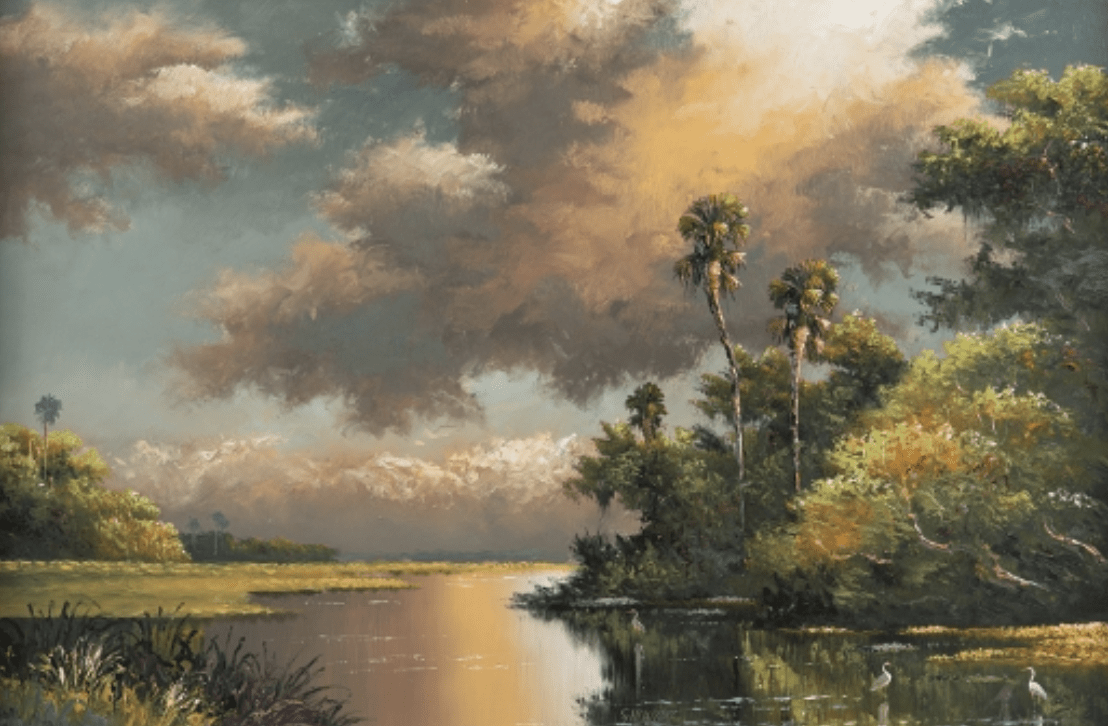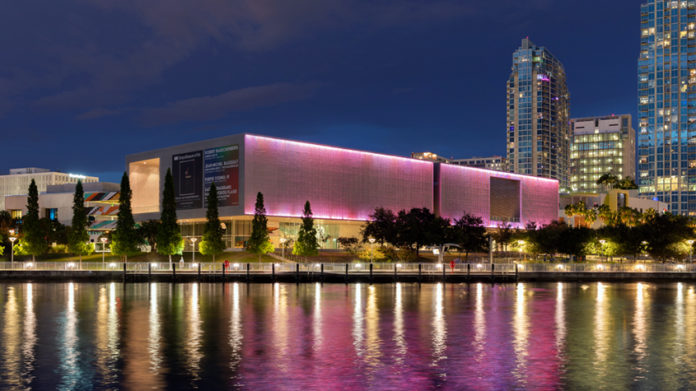Living Color: The Art of Road Workers is the newest exhibition at the Tampa Museum of Art (TMA) in which it continues to celebrate the richness and complexity of Florida’s cultural tapestry.
The Living Color exhibition, which opened on November 19 and until March 28, 2021, brings together 60 paintings from five distinguished private collections, which showcase the work of Florida’s core road workers group.
These renowned African American artists have portrayed the state’s nature and rich tones in their unique self-taught painting styles. The Highwaymen created works of art from the 1950s to the 1980s. Artists, including Al Black, Mary Ann Carroll, Willie Daniels, Johnny Daniels, James Gibson, Alfred Volos, Roy McLendon, Harold Newton, Sam Newton, Willie Reagan, and Livingston Roberts, painted as a means of making money, and many of them were quite successful, especially by Alfred Hair and Harold Newton.
Faced with the constraints imposed by the racial prejudices of their time, robber artists had little formal education or access to traditional art markets. To overcome these obstacles, they produced a large amount of work that could be sold at affordable prices, often door-to-door and sometimes from the trunk of their cars on highways like Route 1.

The Tampa Museum of Art exhibit Living Color has portrayed the state’s natural and rich colors in their unique self-taught drawing styles.
Continuing the pursuit of TMA’s centenary, Tampa Bay residents can look forward to studio art lessons and educational programs that offer a deeper understanding of Highwaymen artwork.
Joanna Robotham, the curator of the contemporary art department at the Tampa Museum of Art, said they are delighted to be able to bring Living Color to Tampa because the exhibit testifies to the ingenuity and resilience of this group of artists. Rogues based in and around Fort Fort. Pierce created his own creative community during a period in Florida history that coincided with the state’s economic boom when African Americans were fighting for equal rights.
Groups of four or more can schedule a private virtual tour, while groups of 10 or more can schedule a personal tour of Living Color and any exhibit at the Tampa museum of art by visiting TampaMuseum.org/Adult-Tours/.
The Tampa Museum of Art exhibit is organized by the Orlando Museum of Art (OMA) and curated by Gary Monroe in collaboration with Hansen Mulford, the Senior Curator at OMA. The fully illustrated catalog, published by OMA in partnership with Living Color, is available from the TMA Museum Store.
The Tampa Museum of Art is presenting this significant exhibition in the Tampa Bay area with sponsorship from the Gobioff Foundation, Souders Foundation, Brown & Brown Insurance, and others.
As the Tampa Museum of Art looks to the future, continued collaboration with businesses and individuals will help the museum grow the heritage of Tampa art and culture that inspires and represents all members of the community.
About the Tampa Museum of Art
Since 1920 the Tampa Museum of Art has been inspiring Tampa Bay residents and others around the world with exciting exhibitions and innovative educational programs that focus on ancient, modern, and contemporary art.
The largest collections of Greek and Roman antiquities in the southeastern USA are kept in the Tampa museum of art. As one of the region’s largest museums dedicated to modern art, the museum’s permanent collection also includes sculpture, photography, painting, new media, and more.
New online programs complement year-round studio drawing lessons, lectures, and tours that provide children, teens, and adults with the opportunity to discover new perspectives and explore different art-making techniques.
Likewise, through unique collaborations with communities, the Museum offers outreach programs that provide art therapy and meaningful ways of expression for vulnerable populations.
Located in the heart of downtown Tampa, adjacent to Curtis Hickson Waterfront and Tampa Waterfront Park, the Tampa Museum of Art is both a cultural institution and a community museum dedicated to the diversity of its hometown.
The Tampa Museum of Art opened its award-winning new home in 2010 with a commitment to providing innovative community programs with a focus on classical and contemporary art.
The museum balances a growing collection, including one of the largest collections of Greek and Roman antiquities in the southeastern United States, with a dynamic annual schedule of special exhibitions.
It is the region’s largest contemporary art museum and has earned a reputation for contemporary photography and new media; most notably, the Leo Villarreal (Tampa) skyscraper, a 14,000-square-foot LED installation on the museum’s south facade, has become an iconic image of Tampa.
Since its founding in 1979, Tampa has been dedicated to providing quality education to students and adults. More than half of its programs are offered free of charge. The museum houses the Sono Café, a Slow Food café overlooking the Hillsborough River, which has become Tampa’s premier venue for special events.
Tampa museum of art exhibits
Figure Forward: Selections from the Permanent Collection

The concept of the body varies from person to person, from artist to artist. The works featured in Drawing Forward: Selected from the Permanent Collection show different approaches to figuration from the 18th century to the present in the permanent collection of the Tampa Art Museum.
Portraiture and figure painting are anchors of the contemporary collection, with works in various media by artists such as José Clemente Orozco, Francisco Goya, Louise Nevelson, Fairfield Porter, Lorna Simpson, and Raphael Sawyer.
The exhibition also features the recent acquisitions of Alex Katz, Igala Ozeri, and Pepe Mar. Figure Forward expands on the figurative works included in the exhibition “Creating a Museum: 100 Years, 100 Works”.
On view October 22, 2020, through May 9, 2021
HerStory: Stories of Ancient Heroines and Everyday Women

To celebrate the 100th anniversary of women’s suffrage, the Tampa Museum of Art presents a series of exhibitions highlighting the achievements of women in the arts. HerStory: Stories of Ancient Heroines and Everyday Women explores the history of women in the ancient world through images of goddesses, heroines, mythological characters, and ordinary women from the Museum’s collection of classic antiquities.
The exhibition features items that talk about the role of women in the ancient world, their myths and stories, from Aphrodite and Athena to Amazon warriors and everyday women. These roles are explored through the museum’s collection of statues, fragments, vessels, and everyday objects.
On view July 9, 2020, through January 9, 2022
Sketches and Sculptures: A Study of C. Paul Jennewein

The paintings of C. Paul Yennewein (German American, 1890–1978) reveal inspiration from the ancient world and interact with the new sculptural styles of his time, combining Art Deco with neoclassical tradition. In 1978, the Tampa Bay Art Center, the predecessor to the Tampa Museum of Art, inherited 2,600 items, including finished works of art, as well as preparatory drawings, plaster casts, and molds for numerous commissions that Jennewane received over her rewarding career.
Sketches and Sculptures: A study by C. Paul Yennewein highlights this vast archive. The exhibit provides an overview of the artist’s early works.
On view through February 28, 2021
White Gold: Thomas Sayre

White Gold is an installation by artist Thomas Sayre. It depicts a southern landscape filled with cotton. The work is intended to express the beauty, complexity, and tragedy of agricultural traditions.
Cotton is one of the most controversial and layered materials in the country. Nearly every American has a personal relationship with it. This is inevitably linked to the economic, racial, and social history of the region and its inhabitants.
Sayra’s white gold refers to cotton and respect for the land, labor, and people (forced or non-violent) who made cotton their source of livelihood. The installation is a vivid expression of the southern landscape: its splendor and the excruciating pain of history, memory, and, ultimately, belonging.
On view through January 10, 2021
Air Fer Mer: Dominique Labauvie

The artist Dominique Labovy (French, R. 1948) unites language, both his native French and English are depicted in his architectural steel sculptures. Air Fer Mer is the title of the outdoor installation on Sullivan’s Terrace, and the title of one of the sculptures on display.
Ephemerality embodies the essence of Labovie’s art. While his industrial steel material suggests a sense of consistency, Labovie seeks to capture fleeting moments in his sculpture – from the movement of light and shadows to the passage of time and life that unfolds around us.
“Air Fer Mer” also translates as “iron, air, sea” – a fitting description of the relationship of objects to the natural world. In this unique location, four Labovie sculptures blend in with the Hillsborough River and the Tampa Museum of Art skyline.
On view through November 30, 2020
The Classical World

The Classical World features Greek, Etruscan, and Roman art and artifacts from the renowned collection of antiques, as well as important loans from local private collectors.
From prehistoric pottery and sculpture (dating back to 3000 BC) to marble sculpture and terracotta from the Roman Empire (dating back to the 5th century AD), the exhibition includes a particularly fine assortment of Greek and southern Italian blacks figured and red-figure vases.
Important works from the collection of antiquities are presented in the exhibition “The Creation of a Museum: 100 Years, 100 Works”.
Ongoing
Ancient and Modern Glass from the Permanent Collection

The objects presented help to illustrate the development of glass production in the classical world over almost a thousand years, from the fourth century BC to the fourth or fifth century AD. The A Closer Look: Ancient Glass collection, created primarily from the permanent collection, includes examples of ancient Greek and Roman glass vessels made using a variety of ancient techniques.

























